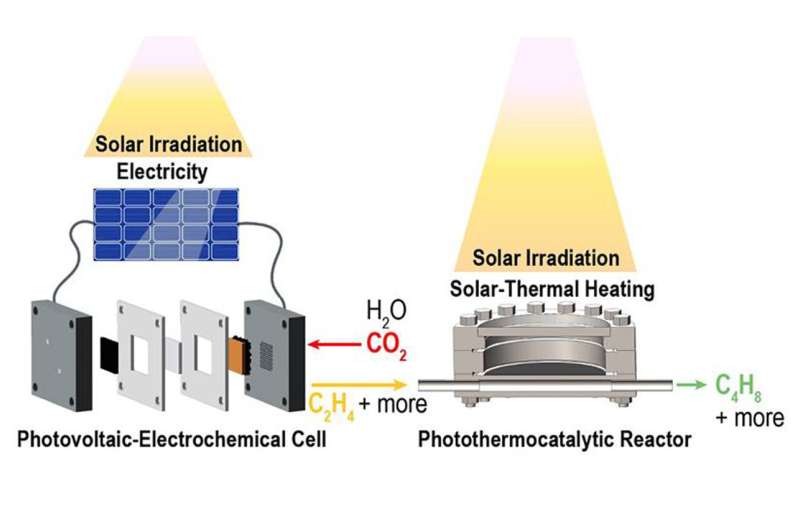Driving chemical transformations through the power of solar energy
Sunlight is a powerful energy source that scientists can leverage to unlock important chemical conversions. In a recent study, researchers used solar energy with a two-step process to convert carbon dioxide (CO2), a potent greenhouse gas, into a valuable chemical commodity.
The work is published in the journal ACS Energy Letters.
Solar fuels enable a pathway for sustainable generation of platform chemicals such as butene directly from solar energy, using CO2 as a feedstock. Industry currently derives butene from fossil fuels. Its generation is energy intensive and emits significant amounts of greenhouse gases. The Liquid Sunlight Alliance process converts CO2 to butene using only energy drawn directly from the sun. This allows butene production to bypass the electrical grid and operate in a stand-alone system.
In this study, researchers developed a two-step chemical cascade process for the single-pass conversion of CO2 to butene, using simulated solar irradiation as the only energetic input.
In the first step, electrochemical CO2 reduction converts CO2 to ethylene using a gas diffusion electrode functionalized with a copper-based catalyst. This reaction uses electricity from an integrated photovoltaic system to drive the chemical reaction. Then, without separation, ethylene in the outlet gas stream feeds directly to a thermo-catalytic reactor, where a nickel-based catalyst transforms ethylene into butene. The thermo-catalytic reactor is powered by a selective solar absorber that is directly and efficiently heated by solar irradiation.
This research shows that solar energy can directly enable chemical conversion to multicarbon products—complex carbon molecules useful for industry. It thus unlocks the potential for innovating other chemical transformations driven directly by renewable energy.
This study also demonstrates the potential for designing modular, solar-driven components and processes to synthesize net-zero carbon fuels, chemicals, and materials that displace carbon-intensive fossil fuels in our industrial cycle. In the future, tandem solar fuel reactions could be a key player in the transition to sustainable, decentralized chemical production.
To enable a transition to clean energy and sustainable production of chemicals, we need scientific advances that lead to technologies that recycle greenhouse gases into valuable products. Powering these technologies with renewable energy will help us reach net-zero emissions.
More information:
Kyra M. K. Yap et al, CO2 Conversion to Butene via a Tandem Photovoltaic–Electrochemical/Photothermocatalytic Process: A Co-design Approach to Coupled Microenvironments, ACS Energy Letters (2024). DOI: 10.1021/acsenergylett.4c01866
US Department of Energy
Citation:
Driving chemical transformations through the power of solar energy (2025, January 13)
retrieved 14 January 2025
from https://techxplore.com/news/2025-01-chemical-power-solar-energy.html
This document is subject to copyright. Apart from any fair dealing for the purpose of private study or research, no
part may be reproduced without the written permission. The content is provided for information purposes only.

Comments are closed